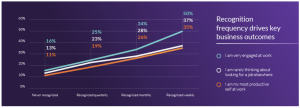Last week TLNT tackled the fascinating topic of the ‘mommy brain’ – a longstanding and pernicious social construct that commentators say many employers leave unquestioned, and as such, causes many women to ‘check-out’ of the US workforce. In short – women feel like they’re no longer capable of holding down top jobs; when the reality is far from this.
This week we turn our attention to looking at how employers can encourage more women to stay – and introduce an HR concept that is starting to get more attention –‘recognition equity’
Let’s start at the beginning
It’s worth noting that participation rates for US working women have – generally speaking – climbed. In fact they hit 58% in April – which is approach the peak rate of 60% achieved in 2000.
But, while this is an undeniably a positive shift – a reflection of growing efforts to promote equality – the fact remains that women and other marginalized group are still getting left behind. And the reason for this is a lack of a culture of equitable recognition.
According to recent Achievers Workforce Institute (AWI) research, a glaring ‘gratitude gap’ in the workforce was revealed.
It found that women are 28% less likely to receive at least monthly monetary recognition than the overall average.
They are also 39% more likely than men to say they never get monetary recognition.
Looking at this data alone, leaders need to take the time to identify recognition gaps and drive overall recognition equity.
Why does recognition matter?
The economic turmoil is turning many organizations to focus only on “business critical” elements and, as a result, C-suites everywhere are tending to push building a culture of frequent and meaningful praise to the bottom of their to-do list.
However, deprioritizing recognition is a huge mistake, given it’s proven to be a critical protective factor against many of the business challenges being navigated in the face of the recession, including layoffs, salary freezes, and heftier workloads.
The reasons why are simple to understand. Recognition is a low-cost, high-impact way to guarantee continued organizational success.
In fact, AWI finds that employees recognized weekly are three times more likely to say they are engaged, productive, and committed to their job compared to those never recognized.
But companies will only reap these benefits if it’s done properly.
How should recognition be given?
A simple “thank you” for a job well done is always welcome, but it won’t move the needle for employees.
Your people want to hear words of praise in a personal, specific, timely and impact-oriented way.
Managers should consider carefully why an employee’s performance is commendable and why they appreciate their hard work.
Then, a manager can deliberately celebrate an employee that dazzled their clients with helpful counsel or inspired their mentee with expert presentation skills.
Also, it should be frequent. One recognition per employee, per month is the recommended recipe for optimal engagement and retention according to AWI.

Source: AWI
How can organizations build recognition equity?
Building committed, productive teams starts with proper, wide-reaching appreciation.
To ensure all employees feel the love, here are some actionable next steps to consider:
Be in the moment and outcome oriented
When you can tie recognitions to outcomes, it focuses less on who the employees are, but instead on the impact they are having at the company. The very nature of focusing on outcomes will mean that business leaders are supporting more equitable recognition. And, when recognition is offered in real-time, it creates equal opportunity for those recognitions to be expressed.
Have open communication:
When organizations gather feedback, they are well-positioned to roll out practices that align with workers’ unique wants and needs, which drives engagement and retention. So much so, that AWI found employees who say their company takes meaningful action on their feedback are 37% less likely to job hunt. Regularly, employees should be asked questions such as: “How often do you feel meaningfully recognized?” and “Do you feel seen and valued in your role?” Once leaders digest feedback, they can review the overall sentiment – and identify concrete next steps to ensure every employee feels seen and appreciated.
Train for giving recognition
Managers need to be flexible and open to learning new skills, especially when it comes to recognition. Interestingly, AWI found that only 53% of managers receive training on recognition best practices, and because of this, many don’t know the qualities needed to make praise effective. HR leaders should mandate recognition training, educate people leaders on the standing gratitude gap and recognition best practices, and ultimately inspire a culture of consistent and equitable praise – from the top down.
Use employee nudging
Even when managers are properly trained, sometimes recognition can fall to the bottom of their exhaustive to-do lists. To ensure employee praise isn’t forgotten, organizations should put employee nudging into practice. In short, a nudge is an aid or signal that provides information to help leaders use their technology and time most impactfully, recognizing trends and offering actionable suggestions. For instance, employees can be nudged that they recognize men 80% of the time on their recognition platform, suggesting they send an accolade to a female teammate instead. With these timely reminders, recognition inequities can be pinpointed quickly and adjusted in real-time.
Remember, volatility has persisted in business for more than three years now, but trying times reveal the most resilient organizations.
Inequity in the workplace is nothing new, but organizations can no longer sit passively as data clearly demonstrates that inequities exist. Business leaders must go through their organizational recognition programs with a fine-tooth comb to check, find and resolve these inequities, to increase overall recognition equity, company-wide.
Tell employees you appreciate them – and empower and encourage them to recognize their colleagues daily.
It will likely be a critical differentiator between businesses that sink and businesses that swim.
